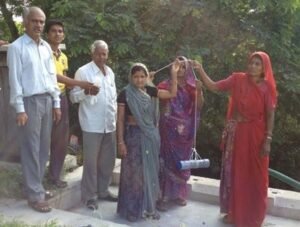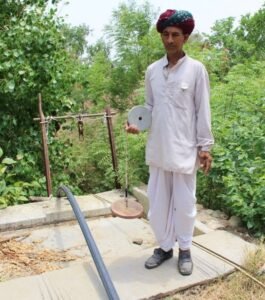


The MARVI project is focused on developing a village level participatory approach, models and tools to assist in improving groundwater supplies and reducing its demand through the direct involvement of farmers and other affected stakeholders.
A unique feature of MARVI is the use of scientific measurements by citizens through the engagement of Bhujal Jankaars (BJs), a Hindi word meaning ‘groundwater informed’ volunteers. With appropriate training and capacity building, BJs monitor groundwater levels and quality, making sense for the village perspective of what is happening to village groundwater availability. BJs convey this information to farmers and others in their own language.
Groundwater level represents the integration of recharge, pumping and flow processes and is a direct measure of groundwater availability and the success of any collective management practices. BJs are an effective, trusted and valuable interface between village communities and government agencies, NGOs and researchers.
An approach for community based participatory groundwater monitoring and management has been developed through a close collaboration with research and development agencies and village communities.
Watertable data monitored by both BJs and sensors have enabled the estimation of local hydro-geologic parameters and the development of simple groundwater balance. The monitoring of rainfall and water levels in checkdams has led to partition of aquifer recharge due to checkdams and natural recharge in relation to subsequent groundwater use.
The SMS system and MyWell app developed helps with easy collection of watertable, rainfall and checkdam water level data from any location in India and making those data available on the web.
BJs are proving to be significant change agents and through their scientific measurement, understanding and communication in the two watersheds. They are also an important interface between researchers and village communities.
As a result of the effective engagement of village communities and evidence shown through local data collected over the last four years, there is an indication that farmers now have started to understand their local groundwater system, accept that groundwater is limited and that the falling watertable is a village level issue and it needs to be tackled at the village level.
The work through MARVI has strengthened the farmers’ view that individual effort alone will not work to solve their groundwater problem. The groundwater level data reveals that deepening wells or installing deeper tubewells is like snatching each other’s groundwater, and overall, no extra water is to be gained by drilling deeper. They have already taken measures to stop deeper drilling, to remove sediment from recharge structures, to determine rabi crop areas from post-monsoon groundwater levels and to improve mulching and water use efficiency and diversify crop types. The farming community in the two watersheds is now debating the concept of sharing groundwater through ‘village groundwater cooperatives’ (VGC). The concept of water productivity, rather than crop productivity, is gaining momentum among the farmers. These are important outcomes from MARVI.
The developed MARVI approach has been tested in two watersheds in Rajasthan and Gujarat over four years, and it is now ready for upscaling to other areas in the two states.
Currently AIWC are in discussions to move towards out scaling MARVI through Southeast Asia, China and Africa.
